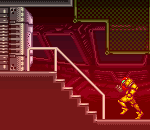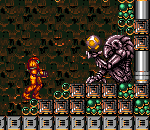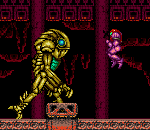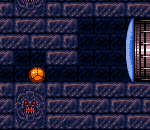Data
Guides and strategies
Media
Super Metroid review
![]() Super Metroid. Some consider it the greatest of Samus' outings, and they probably wouldn't be far from the truth. This timeless classic arrived for the Super Nintendo late last century in 1994 - three years after the portable debut of Metroid II on Nintendo's Game Boy.
Super Metroid. Some consider it the greatest of Samus' outings, and they probably wouldn't be far from the truth. This timeless classic arrived for the Super Nintendo late last century in 1994 - three years after the portable debut of Metroid II on Nintendo's Game Boy.
Returning to the completely open non-linear world formula of the original NES Metroid title, the story continues where Metroid II left off - Samus had conquered the Metroids on their native homeworld of SR388 and was now en route to the Ceres Space Colony with a special delivery - the last infant Metroid she couldn't bring herself to eliminate.
This simple premise thrusts the game into full swing, as before long the colony was attacked and the infant Metroid stolen. Right from the moment of landing aboard the station you already feel the sensation of isolation and the urge to explore - the dark environments and eerie lack of music (only the hum of the station's systems kept you company) instantly set the mood and atmosphere.
Soon after finding the station devoid of life, Samus locates the infant Metroid and confronts Ridley - the space dragon commander of the Space Pirates. Making a hasty escape before the station's self-destruct sequence tears the place apart, Samus tracks Ridley back to planet Zebes - the site of her first battle against the thieves and their army of Metroids. Thus the stage is set.
That's usually all it takes to draw you into this adventure ride. Upon landing on Zebes' surface you'll be completely free to explore the varied environments of the planet. Starting out on a cloudy, rain swept, thunder storm-ravaged landing site, soon you'll find yourself exploring dank caves and retrieving items right before the Space Pirates come out to play.
![]() As a platforming game through and through, Super Metroid takes everything that made the first game successful and literally took it to the 16-bit level. Instead of taking the Mario approach with continuous levels with progression only going forward, the world of Zebes is completely open to explore, with new areas opened up further in the game as the player collects new items and defeats boss monsters. Fans of the original game and Metroid II were in for a treat, as the natural evolution of the series could be seen at every turn.
As a platforming game through and through, Super Metroid takes everything that made the first game successful and literally took it to the 16-bit level. Instead of taking the Mario approach with continuous levels with progression only going forward, the world of Zebes is completely open to explore, with new areas opened up further in the game as the player collects new items and defeats boss monsters. Fans of the original game and Metroid II were in for a treat, as the natural evolution of the series could be seen at every turn.
Did I mention the game's stellar atmospheric environments? Graphically the game draws superb renditions, with colourful characters and a wide variety of environments, from the open plains of Zebes' surface Crateria, to the immense underground caverns, jungles of Brinstar, watery swamps of Maridia and the fires of the planet's core in Norfair. Subtle touches like Samus' arm cannon opening up when selecting Missiles and her slight natural movements while standing still really put the icing on the cake. The detail is enough to inspire the imagination to envisage what the rest of the planet looks like beyond the confines of 2D.
Naturally the game wouldn't succeed nearly as well as it does without audio. Sound effects are deep and clear, and the musical score literally takes you from your seat and draws you into the game's world. Deep ambient scores emphasise the environments and accentuate the atmosphere flawlessly (doesn't the music in the statue chamber just make your spine shiver?). The creepy title theme alone giving you goose bumps is enough to draw you in.
Progression in the game primarily relies on your recovery of incredible items to augment Samus' Power Suit. From a wide variety of beam weapons and other handy tools, such as the jump-enhancing Hi-Jump Boots, screen-clearing Power Bombs and gravity-defying Space Jump, you'll find everything you'll need to explore the world. The power of the SNES also brought this title many a welcome addition, as players could now use a save feature just like in Metroid II rather than record clumsy passwords, and a subscreen recorded your travels on a handy map for reference at any time.
![]() Samus could also finally break free of right-angled aiming and now aim in any of eight directions - made even easier to execute thanks to the L and R shoulder buttons. Control responsiveness simply improved with each game's iteration, and Super Metroid's control scheme left success right up to the player's skill rather than chance. Boss monsters literally fill the screen and take all of your tenacity to conquer.
Samus could also finally break free of right-angled aiming and now aim in any of eight directions - made even easier to execute thanks to the L and R shoulder buttons. Control responsiveness simply improved with each game's iteration, and Super Metroid's control scheme left success right up to the player's skill rather than chance. Boss monsters literally fill the screen and take all of your tenacity to conquer.
Defeating major bosses always rewards you with a new power-up - the game had a neatly packaged reward system as you knew with every new addition to Samus' inventory meant a new area could be opened to explore.
Eventually catching up with Ridley and learning of the Metroid hatchling's fate, players ultimately face the reborn Mother Brain - the mastermind behind the Space Pirate's plans for galactic domination. After an unforgettable finale, the game reveals the time taken to conquer the game and item's collected percentage - faster times mean you'll be treated to a better ending after the credits roll. This added a great incentive for replayability - speed running was born with Metroid and is still enjoyable to this day (although the game would still be incredibly fun to replay without the time-based endings).
![]() All this combined paves the way for one of bounty hunter Samus Aran's greatest space romps that shouldn't be skipped. If you're ever stuck indoors on a rainy day without much to do - break out Super Metroid. Who would have thought something with such a dark moody atmosphere emphasising isolation on a desolate world could turn out to be so engaging? Super Metroid is truly a one-of-a-kind outing for the Super Nintendo and flawlessly stands the test of time to this day.
All this combined paves the way for one of bounty hunter Samus Aran's greatest space romps that shouldn't be skipped. If you're ever stuck indoors on a rainy day without much to do - break out Super Metroid. Who would have thought something with such a dark moody atmosphere emphasising isolation on a desolate world could turn out to be so engaging? Super Metroid is truly a one-of-a-kind outing for the Super Nintendo and flawlessly stands the test of time to this day.
With the game finally making a comeback on the Nintendo Wii's Virtual Console service, nothing should stop you from enjoying this brilliant masterpiece time and again. 10/10, five stars, 100%. This is the reason why 2D platforming exists - don't miss out on one heck of a ride.
Written by Falcon Zero on 18 August 2007.

















